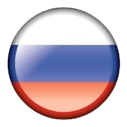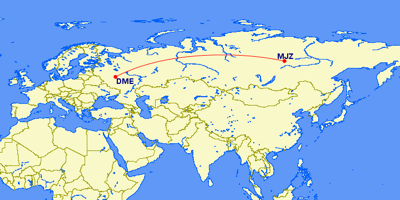From Houston to Sydney 2013

Russian Far East - 2014

I set my alarm for 6:00am in order to fit in an early morning walk before breakfast at 7:00am. With the room still stiflingly hot, getting up was not very difficult at all.
My pre-breakfast walk took me to a large unmarked building in Tikhonova-Pavlova Street that appeared to be either an administrative complex, or perhaps a tertiary college of some kind. The southern end of the building was graced by an unusual series of rough statues showing a (presumably) Arctic researcher surrounded by polar bears and penguins. At the northern end of the building, a large banner proclaimed ‘Glory to Yuri Gagarin”, the first cosmonaut. The mix of decorations was eclectic to say the least.
After breakfast in the hotel, we departed at 8:00am to see Mirny’s key identifying sight, the large open-cut diamond mine that is the second deepest such hole in the world. Before the open-cut mining was replaced by underground pit mining in 2001 for safety reasons (the sides of the pit were unstable and collapsing), the hole had been excavated to a depth of 525 metres (over half a kilometre). The diameter at the top now spans from 1100 to 1200 metres, the diameter at the bottom varies from 160 to 310 metres, and the spiral road to the bottom was 7.7 kilometres in length when it was operational.
To see the hole, we drove to a spot on the eastern side of the pit and climbed some stairs on what used to be a massive piece of pit machinery. The hole was certainly big. It was clear that in the 13 years since the open pit was closed, the sides had fallen because it was now only just possible to see the very rough lines of the roadway that had been used. Indeed, while we were there, a large landslip occurred, leaving a cloud of dust hanging motionless in the still air of the deep pit (see the panorama photo at the bottom of this page). Even though the weather conditions were quite overcast at the time of our visit, the hole was very impressive indeed – photos cannot do it justice and the scale has to be seen to be believed.
The rest of our morning was filled with further stops, though (as expected) none was to be as impressive as the big hole. Our second stop was at the edge of town on the road leading out of Mirny to the south-east. In addition to the usual large monumental sign announcing the town limits of Mirny, a memorial had been built to honour the heroic sacrifices of the workers who had built the road. It was a fitting if simple tribute to the labourers.
The third stop was back in the older part of Mirny, where a somewhat sterile monument had been built on a hill with another ‘tree of life’ at its centre, fronted by a simple sculpture of explorers following a local Yakut person riding a reindeer with his dog. The views on this old part of town were, I thought, far more interesting than the monument.
The fourth stop was at the corner of Komsomol Street and Leningrad Street, where there were several points of interest. Dominating this intersection was a Russian Orthodox Church, built in the early 2000s by Alrosa (of course) as a demonstration of their concern for the spiritual welfare of the residents of Mirny. Interestingly, as part of the church complex, a well equipped school had been constructed. The school was run by the priests and the monks, and has about 150 students in both primary and junior secondary sections.
Another aspect of Alrosa’s apparent concern for the masses was demonstrated in quite a contrasting manner across the road from the church. On this corner, right beside a large war memorial to the sacrifices made by Red Army soldiers during the Great Patriotic War, a statue of Stalin had been erected (also by Alrosa). This was the second statue of Stalin I had seen on this trip, which was two more than I had expected to see.
On a third corner of the same intersection, the side of a building had been covered with a fresco to honour Komsomol (the Communist Youth League), showing medals that had been awarded to the organization from 1928 through to 1968.
Our final visit lasted for an hour (11:00 to 12:00), which most people in the group felt was probably about 55 minutes too long. The town’s geological museum (located across the street from our hotel) has two large rooms of mineral samples, almost all of them grey, placed in an orderly manner on glass shelves. What the display lacked in creativity was complemented (unfortunately) by the interminable and barely coherent, but VERY detailed, explanation by the museum’s curator, Victoria. If there was anything that could be said about Kimberlite and its relationship to diamonds, I am sure we heard it, although I am equally sure we had forgotten most of it by the time we were finally liberated for lunch at midday.
Lunch was provided in the hotel, and at 2:00pm (following some more free time, and therefore another walk around town), we departed for the airport. Everyone else in the group was flying back to Yakutsk to catch their various flights to their next destinations, but I alone was taking a more direct route, flying directly to Moscow from Mirny. Mirny Airport was therefore my point to bid farewell to my fellow travellers who had become good friends over the previous 11 days, and to Simon our tour leader. I have travelled with Simon before (in North Korea), and on this trip he was, as always, the consummate professional - calm under pressure, protective of his group’s interests and needs, well informed and interesting to talk with.
Part 1 of my two-part trip in the Russian Far East had thus come to an end. Part 2 of my trip was about to begin – exploring the Kamchatka Peninsula, an area of geothermal landforms and spectacular scenery in the far east of Russia – even further east than I had travelled so far on this trip.
Common sense would suggest that once a person was in the Russian Far East, it would make sense to fly the shortest route possible to Kamchatka. However, travelling in Russia doesn’t work like that. Not only were the intra-regional flights infrequent (flying just a couple of times per week with woeful connections), they were almost double the cost of flying from Mirny to Moscow, and then back again to Kamchatka.
And so it was that I boarded my Alrosa Airlines Boeing 737 (regrettably, I thought, a late substitution for the scheduled Tupolev Tu-154) at Mirny Airport, departing ten minutes late at 5:40pm, and arriving in Moscow at 5:35pm (also ten minutes late). There was a six hour time difference between Mirny and Moscow (the time difference and the duration of the flight were thus almost identical.
It was not the most comfortable six-hour flight I have ever experienced. In front of me, a boy kept reclining and raising his seat rapidly, seemingly trying to find out how quickly he could do so. That made my space cramped, as my seat was in front of the exit row, meaning it did not recline. In the two seats between me and the aisle, a couple were carrying their Pekinese dog on their laps. The dog had really foul smelling breath and even worse smelling hind quarters, and the air from the overhead vent was nowhere sufficient to freshen the atmosphere.
It was thus a relief to land finally at Moscow’s Domodedovo Airport, one of my favourite airports because of the vast range of rare aircraft and airlines found there, both on the tarmac and in the huge aircraft graveyard lining the runways. I had a repeat of an experience I have had previously at Domodedovo when my luggage failed to arrive on the baggage belt, but when I went to the baggage desk, I found my suitcase was there waiting for me. I simply have no idea why they have separated my suitcase at this airport on two separate occasions, a year apart, in this manner.
Following my positive experience taking the train from the airport in Vladivostok, I decided to take the train from the airport to the hotel upon arrival in Moscow. The one-way taxi fare from the airport to the city in Moscow is 3500 roubles (a little over $100). By contrast, my train fare was 850 roubles ($26), which covered the AeroExpress train from the airport to the city plus the Metro connection to the station near my hotel, and also the equivalent trips tomorrow when I will take the Metro and then connect to the AeroExpress train to Moscow’s other large airport, Sheremetyevo.
I arrived at my hotel at a little before 8:00pm (which was 2:00 am where I woke up in Mirny). It had been a long day - 22 hours to be precise when I finally climbed into bed, ready for a good rest, at 10:00 pm.
Day 11 - Mirny to Moscow
Friday
11 July 2014

Key to airport codes shown on the map: MJZ is Mirny and DME is Moscow-Domodedovo.

































